REPUBLIKA.CO.ID, CARACAS - Venezuelan President Hugo Chavez has nationalized major swaths of the South American OPEC nation's economy as part of a socialist agenda he has promulgated during nearly 13 years in power.
Venezuela was battling about 20 arbitration cases as of late 2011 through the World Bank's International Center for Settlement of Investment Disputes. Below are examples of companies whose assets have been confiscated:
Oil
* In 2007, Chavez's government took a majority stake in four giant oil projects operating in the Orinoco river basin worth an estimated 30 billion USD in total. Exxon Mobil and ConocoPhilips closed up shop in the nation after the government's move and filed arbitration claims.
France's Total SA and Norway's StatoilHydro ASA received about 1 billion USD in compensation after reducing their holdings. Britain's BP Plc and the United States' Chevron Corp remained as minority partners.
* In September 2011, Venezuela proposed paying Exxon 1 billion USD in compensation for its nationalized assets, much less than the company was seeking. Energy Minister Rafael Ramirez said in November 2011 that the government expected verdicts in both cases later in the year.
* In 2008, Venezuela implemented a windfall tax of 50 percent for prices over 70 USD per barrel, and 60 percent on oil over 100 USD. Oil reached 147 USD that year, but soon slumped. In April 2011, the Chavez administration sharply increased windfall taxes as global crude prices again soared above 100 USD.
* In 2009, Chavez seized a major gas injection project belonging to Williams Cos Inc and a range of assets from local service companies.
* In June 2010, the government seized 11 oil rigs from Oklahoma-based Helmerich & Payne Inc.
Agriculture
* In 2009, Chavez nationalized a rice mill operated by a local unit of giant US food company, Cargill Inc.
* In October 2010, Venezuela announced the nationalization of Fertinitro, one of the world's biggest producers of nitrogen fertilizer, as well as the takeover of Agroislena, a major local agricultural supply company. It also said it would take control of nearly 200,000 hectares (494,000 acres) of land owned by British meat company Vestey Foods.
* Vestey had already filed for arbitration over the earlier takeover of a ranch. Chavez said the latest deal with Vestey was a "friendly agreement."
* In 2005, Chavez began implementing a 2001 law letting the state expropriate unproductive farms or seize land without proper titles. He has redistributed millions of acres deemed idle in a bid to boost food production and ease rural poverty.
* The government agreed to pay more than 3 million USD to a group of Spanish farmers for their land.
* Chavez's government has repeatedly threatened to seize Empresas Polar, Venezuela's biggest employer and largest brewer and food processor.
Finance
* In June 2010, Venezuela took over the mid-sized Banco Federal, citing liquidity problems and risk of fraud. The bank was closely linked to anti-government TV station Globovision.
* In 2009, Chavez paid 1 billion USD for Banco de Venezuela, a division of Spanish bank Grupo Santander .
* The government has closed a dozen small banks since November 2009 for what it said were operational irregularities. Some were reopened as state-run companies. Brokerages have also been closed and some employees jailed. Chavez has vowed to nationalize any bank that fails to meet government lending guidelines or is in financial trouble.
Heavy industry
* In October 2010, Chavez ordered the takeover of the local operations of Owens Illinois Inc , a company that describes itself as the world's largest glass container maker. The company has filed an arbitration claim.
* Chavez announced the government takeover of the cement sector in April 2008, targeting Switzerland's Holcim Ltd , France's Lafarge SA , and Mexico's Cemex SAB de CV . Lafarge and Holcim stayed on as minority partners. In November 2011, the government agreed to pay 600 million USD to Cemex.
Gold
* Chavez has considered bringing mining more firmly into state hands. In 2009, officials seized Gold Reserve Inc's Brisas project, which sits on one of Latin America's largest gold veins. Gold Reserve filed for arbitration with the International Center for Settlement of Investment Disputes.
* In August 2011, Chavez announced the government would nationalize its gold industry. Toronto-listed Rusoro Mining Ltd , owned by Russia's Agapov family, is the only large gold miner operating in Venezuela. It produced about 100,000 ounces of gold there in 2010.
Steel
* The government paid 2 billion USD in 2009 for Argentine-led Ternium SA's stake in Venezuela's largest steel mill.
Telecomunications
* In 2007, the nation's largest telecoms company CANTV was nationalized after the government bought out US-based Verizon Communications Inc's 28.5 percent stake for 572 million USD. Analysts said Verizon received fair compensation.
Power
* In 2007, Venezuela expropriated the assets of US-based AES Corp in Electricidad de Caracas, the nation's largest private power producer. The government paid AES 740 million USD for its 82 percent stake in the company. Analysts described the deal as fair for AES.
Transportation
* In September 2011, the government nationalized a local ferry company, Conferry, which operates from the mainland to the resort island of Margarita. Conferry, which is owned by a wealthy family, began operating in 1959.
Tourims
* In October 2011, Chavez said his government would seize private homes on the Los Roques archipelago in the Caribbean and use them for state-run tourism. The islands are among Venezuela's most expensive tourist spots, with pristine white beaches and coral reefs teeming with sea life.



